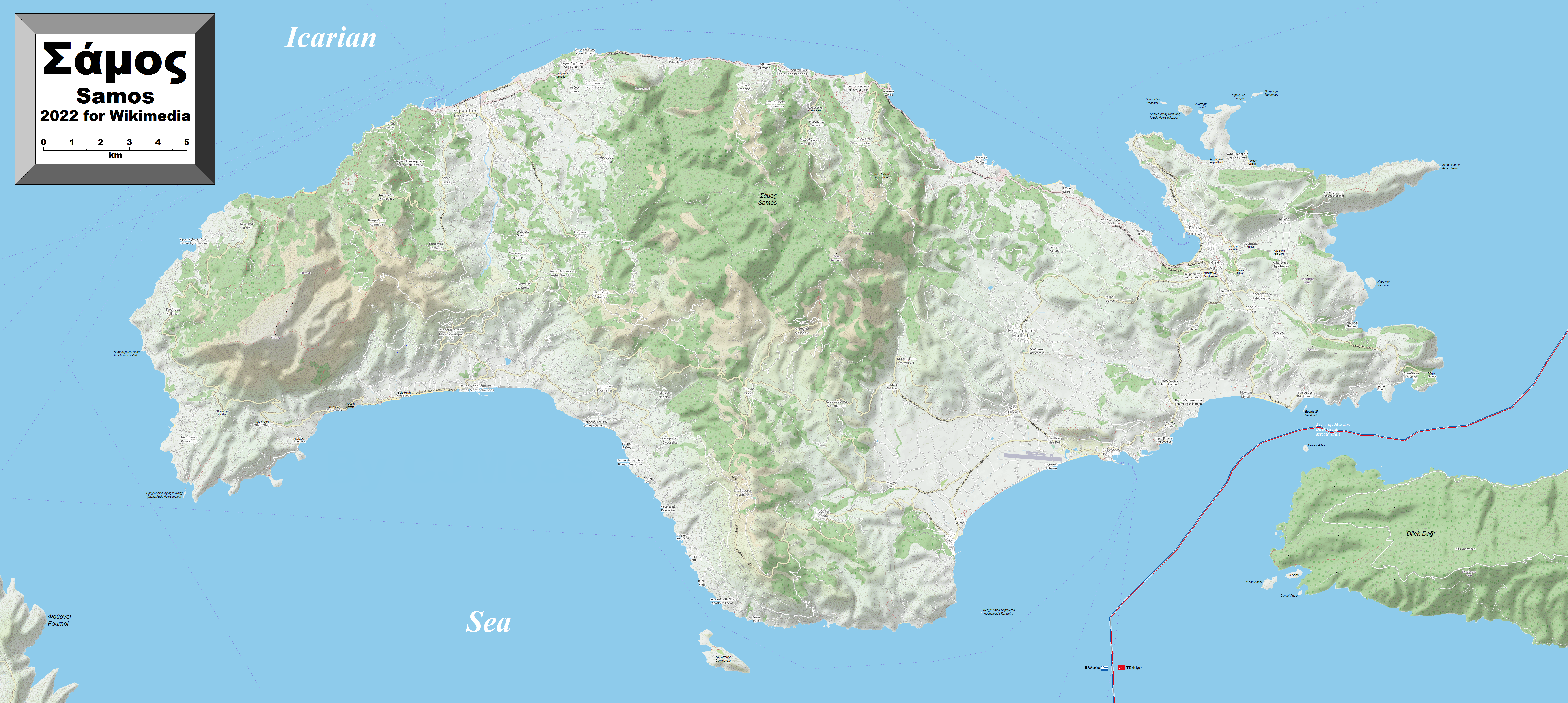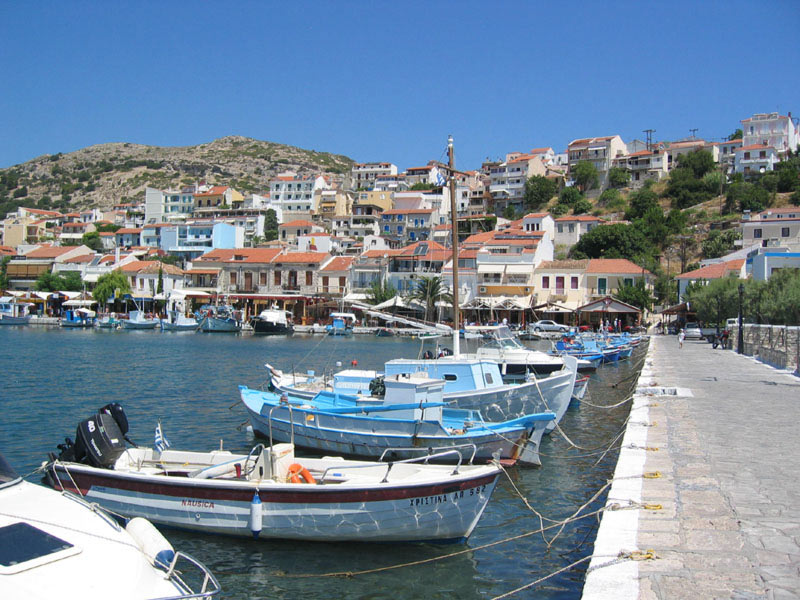|
Ancient Harbour Of Samos
The ancient harbour of Samos was located at the town of Samos (modern Pythagoreio) on the island of Samos. It consisted of a large mole, which was identified in the fifth century BC ancient Greek historian Herodotus as one of three greatest feats of engineering in the Greek world.Herodotus, ''Histories'' 3.60 Large parts of the ancient mole seem to survive, partially incorporated into the modern mole, but these remains are very difficult to date. History The island of Samos became one of the major naval powers in the Aegean in the sixth century BC, culminating in the reign of the tyrant Polycrates. In the fifth century, Herodotus reports a mole surrounded the harbour, with a length of more than two stades out to sea (over 400 metres), and reached a depth of twenty orguia (c. 20 metres). The island's political power declined in the fifth century BC. However, the harbour continued to be a major naval base and an important economic hub, especially under Ptolemaic rule during the H ... [...More Info...] [...Related Items...] OR: [Wikipedia] [Google] [Baidu] |
Samos (town)
Samos ( el, Σάμος, before 1958: Βαθυ - ''Vathy'') is a port town on the island of Samos in Greece. It is the capital of the regional unit of Samos and of the municipality of East Samos East Samos ( el, Ανατολική Σάμος ''Anatoliki Samos'') is a municipality on the island of Samos in the North Aegean region in Greece. The municipality was formed at the 2019 local government reform, when the pre-existing municipality .... It is also known by its old name of Vathy (Βαθύ), though this now usually refers to the old hillside suburb of Ano Vathy. In 2011, Samos Town had a population of 6,251 while the combined population with Ano Vathy is 8,079. History The town of Samos was built in the middle of 18th century as the port of Vathy. At first there were only depots for the necessities of the trade. Samos town was initially named Kato Vathy (meaning lower Vathy) or Limenas Vatheos (port of Vathy). The current name (Samos Town) was given in 1958 when it combin ... [...More Info...] [...Related Items...] OR: [Wikipedia] [Google] [Baidu] |
Hellenistic Period
In Classical antiquity, the Hellenistic period covers the time in Mediterranean history after Classical Greece, between the death of Alexander the Great in 323 BC and the emergence of the Roman Empire, as signified by the Battle of Actium in 31 BC and the conquest of Ptolemaic Egypt the following year. The Ancient Greek word ''Hellas'' (, ''Hellás'') was gradually recognized as the name for Greece, from which the word ''Hellenistic'' was derived. "Hellenistic" is distinguished from "Hellenic" in that the latter refers to Greece itself, while the former encompasses all ancient territories under Greek influence, in particular the East after the conquests of Alexander the Great. After the Macedonian invasion of the Achaemenid Empire in 330 BC and its disintegration shortly after, the Hellenistic kingdoms were established throughout south-west Asia (Seleucid Empire, Kingdom of Pergamon), north-east Africa ( Ptolemaic Kingdom) and South Asia ( Greco-Bactrian Kingdom, Indo-Gre ... [...More Info...] [...Related Items...] OR: [Wikipedia] [Google] [Baidu] |
Ancient Samos
Samos (, also ; el, Σάμος ) is a Greek island in the eastern Aegean Sea, south of Chios, north of Patmos and the Dodecanese, and off the coast of western Turkey, from which it is separated by the -wide Mycale Strait. It is also a separate regional unit of the North Aegean region. In ancient times, Samos was an especially rich and powerful city-state, particularly known for its vineyards and wine production. It is home to Pythagoreion and the Heraion of Samos, a UNESCO World Heritage Site that includes the Eupalinian aqueduct, a marvel of ancient engineering. Samos is the birthplace of the Greek philosopher and mathematician Pythagoras, after whom the Pythagorean theorem is named, the philosophers Melissus of Samos and Epicurus, and the astronomer Aristarchus of Samos, the first known individual to propose that the Earth revolves around the sun. Samian wine was well known in antiquity and is still produced on the island. The island was governed by the semi-au ... [...More Info...] [...Related Items...] OR: [Wikipedia] [Google] [Baidu] |
Angeliki Simossi
Angeliki ( el, Αγγελική), literally "Angellike", is a Greek female given name. Notable people with the name include: *Angeliki Gremou (born 1975), Greek rower *Angeliki Kanellopoulou (born 1965), Greek tennis player *Angeliki Papoulia Angeliki Papoulia ( gr, Αγγελική Παπούλια; born 1975) is a Greek actress and theatre director. In film, she is most notable for her roles in ''Dogtooth'', ''Alps'' and '' The Lobster'' by Yorgos Lanthimos, and '' A Blast'' and ... (born 1975), Greek actress {{given name Greek feminine given names ... [...More Info...] [...Related Items...] OR: [Wikipedia] [Google] [Baidu] |
Ephorate Of Underwater Antiquities
The Ephorate of Underwater Antiquities ( el, Εφορεία Εναλίων Αρχαιοτήτων) is a department within the Greek Ministry of Culture responsible for underwater archaeology. The Ephorate was founded in 1976, and has jurisdiction over the entirety of Greece (unlike the regional antiquities ephorates). Permission from the EUA is needed to conduct surveys and photography dives on architectural structures, such as shipwrecks, in Greek waters. The EUA itself is also responsible for the discovery, exploration, and maintenance of underwater activities. The Ephorate operates two regional offices, based in Thessaloniki and Heraklion. In 2003, the Ephorate was given jurisdiction over all wrecks of ships and aircraft more than fifty years old. A Museum of Underwater Antiquities is currently being designed, under the auspices of the EUA. It will be situated in the harbour of Piraeus Piraeus ( ; el, Πειραιάς ; grc, Πειραιεύς ) is a port city withi ... [...More Info...] [...Related Items...] OR: [Wikipedia] [Google] [Baidu] |
Underwater Excavation
Underwater archaeology is archaeology practiced underwater. As with all other branches of archaeology, it evolved from its roots in pre-history and in the classical era to include sites from the historical and industrial eras. Its acceptance has been a relatively late development due to the difficulties of accessing and working underwater sites, and because the application of archaeology to underwater sites initially emerged from the skills and tools developed by shipwreck salvagers. As a result, underwater archaeology initially struggled to establish itself as actual archaeological research. This changed when universities began teaching the subject and a theoretical and practical base for the sub-discipline was firmly established in the late 1980’s. Underwater archaeology now has a number of branches including, maritime archaeology: the scientifically based study of past human life, behaviours and cultures and their activities in, on, around and (lately) under the sea, estuari ... [...More Info...] [...Related Items...] OR: [Wikipedia] [Google] [Baidu] |
Breakwater (structure)
A breakwater is a permanent structure constructed at a coastal area to protect against tides, currents, waves, and storm surges. Part of a coastal management system, breakwaters are installed to minimize erosion, and to protect anchorages, helping isolate vessels within them from marine hazards such as prop washes and wind-driven waves. A breakwater, also known in some contexts as a jetty, may be connected to land or freestanding, and may contain a walkway or road for vehicle access. On beaches where longshore drift threatens the erosion of beach material, smaller structures on the beach, usually perpendicular to the water's edge, may be installed. Their action on waves and current is intended to slow the longshore drift and discourage mobilisation of beach material. In this usage they are more usually referred to as groynes. Purposes Breakwaters reduce the intensity of wave action in inshore waters and thereby provide safe harbourage. Breakwaters may also be small stru ... [...More Info...] [...Related Items...] OR: [Wikipedia] [Google] [Baidu] |
Byzantine
The Byzantine Empire, also referred to as the Eastern Roman Empire or Byzantium, was the continuation of the Roman Empire primarily in its eastern provinces during Late Antiquity and the Middle Ages, when its capital city was Constantinople. It survived the fragmentation and fall of the Western Roman Empire in the 5th century AD and continued to exist for an additional thousand years until the fall of Constantinople to the Ottoman Empire in 1453. During most of its existence, the empire remained the most powerful economic, cultural, and military force in Europe. The terms "Byzantine Empire" and "Eastern Roman Empire" were coined after the end of the realm; its citizens continued to refer to their empire as the Roman Empire, and to themselves as Romans—a term which Greeks continued to use for themselves into Ottoman times. Although the Roman state continued and its traditions were maintained, modern historians prefer to differentiate the Byzantine Empire from Ancient R ... [...More Info...] [...Related Items...] OR: [Wikipedia] [Google] [Baidu] |
Ashlar
Ashlar () is finely dressed (cut, worked) stone, either an individual stone that has been worked until squared, or a structure built from such stones. Ashlar is the finest stone masonry unit, generally rectangular cuboid, mentioned by Vitruvius as opus isodomum, or less frequently trapezoidal. Precisely cut "on all faces adjacent to those of other stones", ashlar is capable of very thin joints between blocks, and the visible face of the stone may be quarry-faced or feature a variety of treatments: tooled, smoothly polished or rendered with another material for decorative effect. One such decorative treatment consists of small grooves achieved by the application of a metal comb. Generally used only on softer stone ashlar, this decoration is known as "mason's drag". Ashlar is in contrast to rubble masonry, which employs irregularly shaped stones, sometimes minimally worked or selected for similar size, or both. Ashlar is related but distinct from other stone masonry tha ... [...More Info...] [...Related Items...] OR: [Wikipedia] [Google] [Baidu] |
Pythagoreio
Pythagoreio ( el, Πυθαγόρειο) is a town and municipal unit on the island of Samos, North Aegean, Greece. Before the 2011 local government reform, Pythagoreio was a municipality. Since 2019, it is a municipal unit of East Samos. In 2011, the town's population was 7,996. It is the largest municipal unit in land area on Samos, at . It shares the island with the municipal units of Vathy, Karlovasi, and Marathokampos. The archaeological remains in the town, known collectively as Pythagoreion, has designated a joint UNESCO World Heritage Site with nearby Heraion. The seat of the municipality was the town of Pythagorio, formerly known as Tigani. The town was renamed in 1955 to honour the locally born mathematician and philosopher Pythagoras. The port of the town is considered to be the oldest man-made port of the Mediterranean Sea. History Pythagorio is built on the ancient city of Samos. Some ruins of the ancient city are today incorporated in modern houses of Pythagori ... [...More Info...] [...Related Items...] OR: [Wikipedia] [Google] [Baidu] |
Orguia
A fathom is a unit of length in the imperial and the U.S. customary systems equal to , used especially for measuring the depth of water. The fathom is neither an International Standard (SI) unit, nor an internationally-accepted non-SI unit. Historically, however, it is the most frequently employed maritime measure of depth in the English-speaking world. There are two yards (6 feet) in an imperial fathom. Originally the span of a man's outstretched arms, the size of a fathom has varied slightly depending on whether it was defined as a thousandth of an (Admiralty) nautical mile or as a multiple of the imperial yard. Formerly, the term was used for any of several units of length varying around . Name The name (pronounced ) derives from the Old English word ''fæðm'', cognate to the Danish (via the Vikings) word "favn" meaning embracing arms or a pair of outstretched arms. Cognate maybe also via the Old High German word "fadum" of the same meaning.''Oxford English Dictiona ... [...More Info...] [...Related Items...] OR: [Wikipedia] [Google] [Baidu] |






